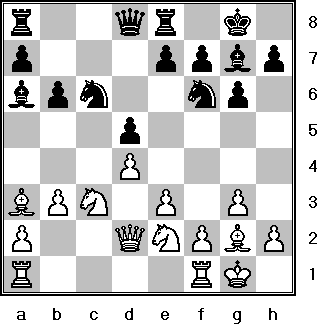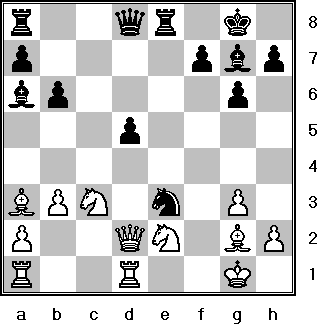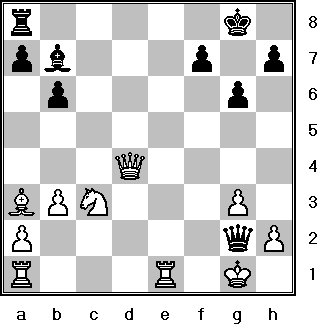-
1. d4 Nf6
2. c4 g6
3. g3 c6
4. Bg2,
An alternative was 4.d5!? b5! 5.dxc6 bxc4 6.cxd7+ Nbxd7 7.Bg2 Rb8; 8.Nf3 Bg7 9.0-0 0-0 R. Byrne - Bobby Fischer; U.S. Championship, New York, 1962/63. "Black's weak QBP is compensated for by pressure on the open QN-file." - Fischer
4...d5
A Neo-Gruenfeld
5. cxd5 cxd5
6. Nc3 Bg7

7. e3?!
A seemingly passive move
7...0-0
8. Nge2 Nc6
9. 0-0 b6
10. b3!?
Fischer gives 10.Nf4!? e6; 11.b3 Ba6; 12.Re1 Rc8; 13.Ba3 Re8; 14.Rc1, Stahlberg - Flohr; Kemeri, 1937- " with deadeye equality." Fischer.
10...Ba6
Pinning the knight on e2 to the rook on f1.
11. Ba3 Re8!
Black begins positioning his pieces for a liberating pawn break.
Not 11...e6?? 12.Bxf8 and white is winning.
12. Qd2?!
A logical move, White connects his Rooks in preparation for their mobilization. However the White Queen will find she is more prone to tactics on this square and Rc1 is better.
(12. Rc1!? e6! 13. dxe5 Nxe5 14.Rc2! (14. Nxd5? Nxd5 15. Bxd5 Bxe2 with an edge to black) 14...Bb7 15. Rd2! and white is better- Fischer.)
Here is how GM Andrew Soltis describes the position (After 12. Qd2!?): Byrne's reliance on caution here is based on a simple plan. He will build up heavy pieces on the c-file. If Black does the same White will have the time to engineer some sort of breakthrough in the center. Of course, if Black tries a breaktrhough, such as with ...e5, he will be left with a horribly weak d-pawn after dxe5. Of course."

12...e5!
"I was amazed at this advance, which seems to leave Black's Queen-Pawn a hopelessly weak isolani" admitted R. Byrne in 'Chess Life.'
"I was a bit worried about weakening my QP, but felt that the tremendous activity obtained by my minor pieces would permit White no time to exploit it." - and - "12...e6 would probably lead to a draw." - Fischer.
13. dxe5!?
This is the first choice of just about any computer program.
"Passive is 13. Rac1 exd4; (13...Rc8; 14. Rfd1 e4; 15. f3 is tenable) 14. exd4 Rc8; 15. f3 although its difficult for Black to break through"- Fischer. Life Master AJ Goldsby gives 15...b5! as favoring black after extensive computer analysis.
GM John Emms gives the variation: 15. Rfe1! Bxe2; 16.Rxe2 Nxd4; 17.Rxe8+ Qxe8; 18.Re1!, (18. Qxd4? Ne4 favors black) 18...Ne4; 19. Nxe4 dxe4; 20. Rxe4 and now J. Emms states: " ... this actually favors White, who keeps the Bishop-pair." [ GM Emms, in "The World's Greatest Chess Games." Game # 50. It should be noted most computers consider this position about = even after searching for an hour or more--MD Cox
13...Nxe5
14. Rfd1?!

Fischer points out that this is the wrong rook. However it should be realized that Byrne did not even consider Rad1, since he wants to put pressure on d5 with Nf4 and it was pinned against the f1-rook on the a6-f1 diagnol. The text was a perfectly logical move.
Better was 14.Rad1! Qc8! to maintain the initiative. 15. Rc1, Maybe the best for White. 15...Qd7! 16. Rfd1 Rad8!? Fischer thinks Black is OK here. "Black has finangled a precious tempo." - Fischer.
14...Nd3!
This knight outpost is quite strong due to whites amazing and unsuspected tactics.
15. Qc2
White does not have alot of choices here as he must prevent 15...Ne4 16. Nxe4, dxe4 when black has a strategically winning position due to the 'monster' on d3. -GM Bogdan Lalic
White can try 15.Nc1!? Black black is better after 15...Ne4 as above.
Or 15.Nf4!? d4! with an attack -Prins
Or 15. Nd4 Ne4 16.Nxe4 dxe4 17. Bb2 Rc8 "with a powerful bind." - Fischer. And 15.f3 Bh6; 16.f4, (Not 16.Nf4? d4! winning) 16...Bg7! with an advantage to black. - Fischer. ]
15...Nxf2!!

16. Kxf2 Ng4+;
17. Kg1
Forced.
Not 17. Kf3? Rxe3+! 18.Kxg4 (18. Kf4 Bh6+ 19.Kxg4 Bc8+) 18...h5+ 19.Kh3, (19.Kf4?? Bh6# ) 19...Bc8+ "and Black will shortly deliver checkmate." (Variation by - GM J. Emms.) Also bad is: 17. Ke1?! Nxe3; 18. Qb1 Nxg2+' winning.
17...Nxe3
Where is Black going?
18. Qd2
Definitely not: 18...Nxd1? 19.Rxd1 and White is better.
Nothing can add up to Byrne's own words:
"As I was sitting there wondering why Bobby would play such an obviously bad and lost continuation as 18...Nxd1? there came..."

18...Nxg2!!
"...suddenly the brilliant move 18...Nxg2!! Then it dawned on me that Bobby was not interested in winning material, but that the White King was the object of his attack...." [Chess Life and Review Annual 1964] "This dazzling move came as the shocker....The culminating combination is of such depth that at the very moment I resigned, both grandmasters commenting on the play for the spectators in a separate room believed that I had a won game" (Fischer's 60 Memorable Games)
Rossolimo was saying downstairs -"Black refuses to take the rook! Maybe the wrong move had been telephoned downstairs?" Across the board, however, after the initial shock had died down, White began to realize the strength of the two enemy bishops was working up a mating attack.
19. Kxg2 d4!
Square vacation. Fischer clears d4 to open the a8-h1 long diagnol.
20. Nxd4 Bb7+
21. Kf1
Other King moves were no better:
21. Kg1 Bxd4+ 22. Qxd4 Re1+! 23. Kf2 Qxd4+; 24. Rxd4 Rxa1 25. Rd7 Rc8 26.Rxb7, (26. Bb2 Rh1) 26...Rxc3 27. Rb8+ Kg7 28. Bb2 Rxa2 Black is winning - Fischer.
Or 21. Kf2 Qd7! 22.Rac1, (22. Nce2 Qh3; 23.Nf3, (Or 23.Ke1 Qxh2 24.Qb2 Ba6) 23...Bxa1; 24.Rxa1, (Or 24. Neg1 Qf5; 25. Rxa1 Rad8; 26. Qb2 Rd3 24...Rad8; 25.Qc2 Qe6! black is winning - GM J. Emms.) 22...Qh3 23. Nf3 Bh6 24. Qd3 Be3+ 25. Qxe3 Rxe3 26. Kxe3 Re8+ 27. Kf2 Qf5! black is winning - Fischer.
21...Qd7!

And Here White Resigned even as other GM's were saying that it was black who should resign!
"I don't understand this at all," Rossolimo was saying with some exasperation. The moves had been checked and double-checked by telephone. But "Fischer has nothing at all for his piece," he said. Sherwin said it wasn't all that clear, but he wasn't sure. And then, the news came ... White had resigned! Rossolimo was in shock until Byrne came down to show everyone the key lines. GM Rueben Fine was also saying Black was lost and wanted to show Robert how he could escape but with each variation Byrne would only shake his head sadly and demonstrate another one of Bobby Fischer's intended winning variations!
For sake of clarity I give Fischer's intended continuation:
22. Qf2
Whites best move.
If 22. Ndb5 Qh3+; 23. Kg1 Bh6! mating - Fischer.
Or 22. Kg1 Bxd4+! (22...Rad8 23. Qxd4 Re1+! 24. Kf2 Qxd4+; 25. Rxd4 Rxa1 26. Rd7 Rc8! 27. Rxb7, ( 27. Bb2 Rh1!) 27...Rxc3 28. Rb8+ Kg7 29. Bb2 Rxa2 An easy win for Black.
22...Qh3+
23. Kg1 Re1+!!

The move overlooked by even Grandmasters. So if now 24. Qxe1, then 24...Qg2#.}
24. Rxe1 Bxd4
25. Qxd4
(25. Re3 Bxe3 wins)
25...Qg2#

One of the most amazing checkmates of all time!!!
Tactical Themes: pin, demolition, exploiting unfortunate piece position, square vacation, enticement
Mating Themes: Weak Color Complex Mate, 2 Bishop Mate, Long Diagnol Mate, Queen and Bishop Mate.
I consider this to be the 3rd greatest attacking game of all time.